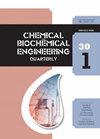Photocatalytic Oxidation of Rhodamine 6G Dye Using Magnetic TiO2@Fe3O4/FeZSM-5
IF 0.9
4区 生物学
Q4 BIOTECHNOLOGY & APPLIED MICROBIOLOGY
引用次数: 2
Abstract
Efficient decolorization of Rhodamine 6G dye (Rh 6G) using magnetic TiO2@ Fe3O4/FeZSM-5 photocatalyst was carried out in a batch reactor equipped with two visible lights (high-pressure Na lamps). The photocatalyst was synthesized and characterized by X-ray diffraction, scanning electron microscopy, energy dispersive X-ray spectroscopy, diffuse reflectance spectroscopy and vibrating sample magnetometry. The effects of initial Rh 6G concentration, catalyst loading, and pH were investigated on photocatalytic oxidation of Rh 6G. Maximum decolorization of 98.2 % was found at optimum conditions of 20 ppm Rh 6G, 1 g L–1 of catalyst, and pH of 13.04. Central composite design was used for the optimization of photocatalytic degradation of Rh 6G. Predicted decolorization efficiencies were found to be in good agreement with experimental values with high regression coefficient of 98.8 %. In addition to color removal, the toxicity of the Rh 6G aqueous solution was significantly reduced after photocatalytic oxidation. Small reduction of activity (from 34.6 % to 30.5 %) showed the stability of the catalyst after three consecutive runs. Due to the magnetic property of the catalyst, it could be removed from the solution with the help of external magnetic field. This prevents the loss of catalyst and reduces the extra separation cost, which is desired in industrial or large-scale applications.磁性TiO2@Fe3O4/FeZSM-5光催化氧化罗丹明6G染料
在配备两盏可见光(高压钠灯)的间歇式反应器中,采用磁性TiO2@ Fe3O4/FeZSM-5光催化剂对罗丹明6G染料(Rh 6G)进行了高效脱色。合成了光催化剂,并用x射线衍射、扫描电镜、x射线能谱、漫反射光谱和振动样品磁强计对其进行了表征。考察了初始Rh 6G浓度、催化剂负载和pH对Rh 6G光催化氧化的影响。在Rh为20 ppm、催化剂为1 g L-1、pH为13.04的条件下,脱色率达到98.2%。采用中心复合设计优化光催化降解Rh 6G的工艺。预测脱色效率与实验值吻合良好,回归系数高达98.8%。除除颜色外,光催化氧化后的Rh 6G水溶液的毒性也显著降低。连续运行三次后,活性略有下降(从34.6%降至30.5%),表明催化剂的稳定性。由于催化剂的磁性,它可以在外加磁场的帮助下从溶液中去除。这防止了催化剂的损失,降低了额外的分离成本,这是工业或大规模应用所需要的。
本文章由计算机程序翻译,如有差异,请以英文原文为准。
求助全文
约1分钟内获得全文
求助全文
来源期刊
CiteScore
2.70
自引率
6.70%
发文量
23
审稿时长
>12 weeks
期刊介绍:
The journal provides an international forum for presentation of original papers, reviews and discussions on the latest developments in chemical and biochemical engineering. The scope of the journal is wide and no limitation except relevance to chemical and biochemical engineering is required.
The criteria for the acceptance of papers are originality, quality of work and clarity of style. All papers are subject to reviewing by at least two international experts (blind peer review).
The language of the journal is English. Final versions of the manuscripts are subject to metric (SI units and IUPAC recommendations) and English language reviewing.
Editor and Editorial board make the final decision about acceptance of a manuscript.
Page charges are excluded.

 求助内容:
求助内容: 应助结果提醒方式:
应助结果提醒方式:


